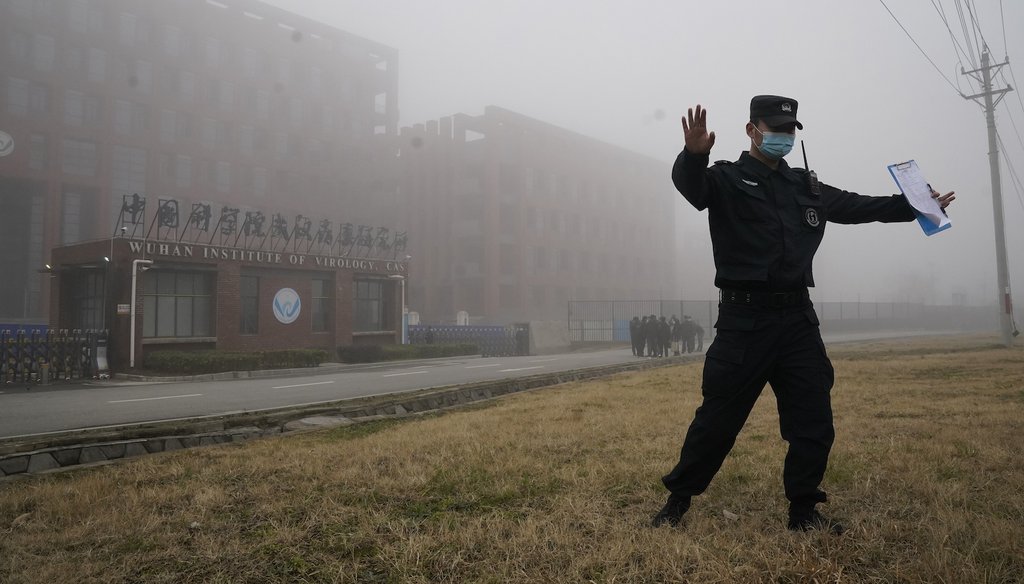Stand up for the facts!
Our only agenda is to publish the truth so you can be an informed participant in democracy.
We need your help.
I would like to contribute

A security official moves journalists away from the Wuhan Institute of Virology after a World Health Organization team arrived for a field visit in Wuhan in China's Hubei province on Wednesday, Feb. 3, 2021. (AP)
If Your Time is short
-
A letter written by Dr. Lawrence Tabak has been cited as proof that the National Institutes of Health funded “gain of function” research in Wuhan, China, despite denials from U.S. health officials. Gain-of-function refers to a wide range of interventions, muddying the debate over which types of research do and don’t meet that definition.
-
Scientists we asked were split on the question of whether the experiment described in the letter constituted high-risk gain-of-function research and warranted additional review from the federal government.
-
A steady leak of documents, including grant proposals and progress reports from the nonprofit EcoHealth Alliance, have revealed a range of experiments that some view as circumstantial evidence supporting a laboratory origin of COVID-19.
-
There is still no direct evidence that SARS-CoV-2 was created in a lab.
Congressional Republicans have seized on a letter written by a top official from the National Institutes of Health, claiming that it proves the agency funded "gain of function" research in Wuhan, China, the site of the first known coronavirus outbreak.
In an Oct. 20 letter to Rep. James Comer, R-Ky., Dr. Lawrence Tabak, principal deputy director of the NIH, said that the Wuhan Institute of Virology and the nonprofit group EcoHealth Alliance conducted experiments on bat coronaviruses with NIH funding.
The NIH said the experiment described in the letter could not have created SARS-CoV-2. However, it also said EcoHealth Alliance violated the terms of its grant and that it had requested that EcoHealth turn over all data involving its grant-funded experiments by Oct. 25.
These developments relate to the broader debate over the origins of the coronavirus. Early in the pandemic, the consensus among public health experts was that SARS-CoV-2 had evolved naturally in a bat and jumped to humans through an intermediary species. Since then, some scientists have publicly raised questions about whether the virus somehow originated in a lab in Wuhan through gain-of-function experiments.
Gain-of-function research involves experiments in which new attributes are given to an organism. Some forms of gain-of-function research are relatively harmless; however, others can involve the enhancement of a virus’s transmissibility or lethality and are extremely controversial.
Republican politicians immediately cast the letter as an admission of guilt from the NIH.
"NIH confirmed today EcoHealth and the (Wuhan Institute of Virology) conducted (gain-of-function) research on bat coronaviruses," tweeted the Republican staff of the House Oversight and Reform Committee. Comer, the recipient of the letter, went so far as to falsely claim that the document "proves all along that this virus was started in the Wuhan lab."
Dr. Anthony Fauci, head of the National Institute of Allergy and Infectious Diseases, has denied in a series of high-profile exchanges with Sen. Rand Paul and in an interview with PolitiFact that the NIH funded gain-of-function research.
"The NIH and NIAID categorically have not funded gain-of-function research to be conducted in the Wuhan Institute of Virology," he told Paul in May 2021.
The NIH has stayed firm on its claim that the experiments described in the Tabak letter were not high-risk gain-of-function research. However, the scientists we interviewed were split on the question, with some saying that the experiment was within the bounds of normal virology research and others calling it highly risky.
What are the government’s rules for gain-of-function research?
The term "gain of function" refers to a wide variety of interventions, and the definition has shifted over time, making it easy for scientists to talk past one another. Proponents claim that high-risk forms of this research help scientists anticipate the evolutionary paths of viruses and come up with cures. Critics claim that it constitutes a massive biosafety hazard.
In 2014, the government issued a pause on federal funding to gain-of-function experiments, specifically barring "research projects that may be reasonably anticipated to confer attributes to influenza, MERS, or SARS viruses such that the virus would have enhanced pathogenicity and/or transmissibility in mammals via the respiratory route."
However, there’s an exception in the moratorium that allows gain-of-function for research "urgently necessary to protect public health or national security."
Three years later, the Department of Health and Human Services developed a new framework, known as the "P3CO framework," for proposed research projects involving experiments with "potential pandemic pathogens." The framework requires that "extra care" and a "multidisciplinary review" be given to experiments that are "reasonably anticipated to create, transfer or use potential pandemic pathogens resulting from the enhancement of a pathogen’s transmissibility and/or virulence in humans." Not all forms of gain-of-function trigger extra review, only specific ones deemed high-risk.
What was EcoHealth Alliance doing?
EcoHealth Alliance is a nonprofit that studies infectious diseases, including bat coronaviruses. It has long been the subject of criticism and speculation from proponents of the lab-leak theory for research it conducted into bat coronaviruses in Wuhan.
EcoHealth Alliance’s critics received a boost in September when the investigative reporting outlet The Intercept published 900 pages of documents containing grant proposals and progress reports involving the nonprofit. These documents shed new light on the NIH-funded experiments that EcoHealth was conducting on bat coronaviruses, including the one discussed in the Tabak letter. A month later, The Intercept also broke the news of a parallel experiment involving the alteration of Middle East Respiratory Syndrome, or MERS, an extremely deadly virus.
Around the same time, independent investigators leaked a 2018 grant proposal written by EcoHealth that described an experiment involving the insertion of a "furin cleavage site" onto a bat coronavirus. While the grant was eventually rejected and the experiment was to take place in North Carolina, rather than China, proponents of the lab-leak theory seized on the development, as scientists had long puzzled over a similar feature on SARS-CoV-2.
In the experiment mentioned in the Tabak letter, researchers attached spike proteins from specific bat coronaviruses onto another bat virus, called WIV1, and then tested its ability to connect to a human receptor protein called ACE2, which was engineered onto mice.
Tabak wrote that the NIH eventually determined that the experiment did not warrant special review under the P3CO framework. However, additional language was included in the grant "out of an abundance of caution," stipulating that EcoHealth notify the NIH if the engineered viruses grew at 10 times the rate of WIV1.
The virus that EcoHealth and its partners created had a viral load 1,000 to 10,000 times greater than WIV1, enough by several orders of magnitude to provoke additional review. Nevertheless, Tabak alleged that EcoHealth failed to report this fact until August 2021, nearly two years overdue.
EcoHealth Alliance denied the NIH’s claim, saying in a statement: "These data were reported as soon as we were made aware, in our year four report in April 2018."
Tabak’s letter describing the experiment doesn’t contain the words "gain of function." However, the NIH told PolitiFact that the experiment did not meet the NIH definition of high-risk gain-of-function research under the P3CO framework, because the bat coronaviruses used had not been shown to infect humans and the experiments were not reasonably expected to increase transmissibility or virulence in humans.
"The (NIH) did not support the kind of ‘gain of function’ research warranting the additional and unique P3CO oversight identified by stakeholders during extensive prior policy development," the NIH said in a statement to PolitiFact. "To claim otherwise is incorrect and irresponsible."
Some scientists say experiment wasn't gain-of-function
Several scientists told PolitiFact they agreed with the NIH.
Joel Wertheim, an evolutionary biologist at the University of California San Diego, said that he didn’t think that the researchers could have reasonably anticipated their research to have created a virus with higher transmissibility in humans.
Robert Garry, a professor of microbiology and immunology at Tulane University School of Medicine, agreed with Wertheim, drawing a distinction between experiments like the one EcoHealth conducted that try to assess a virus’s virulence and those that try to enhance it.
Michael Imperiale, a University of Michigan virologist and 10-year member of the National Science Advisory Board for Biosecurity, said that he didn’t consider the experiment to be outside the boundaries of normal virology research. "You’ve got a virus that you know can infect humans and can cause severe disease, so you have to take precautions," he said. "But it’s no more risky than working with SARS or MERS."
He also noted that the experiment did not necessarily create a virus that can sicken humans. "Just because it can infect a human cell doesn’t mean it can cause disease in humans," he said. "The other corollary to that is just because a virus replicates better doesn’t mean it’s going to cause more severe disease in humans."
Some scientists say experiment epitomized gain-of-function
Some scientists disagreed.
Richard Ebright, a professor of chemistry and chemical biology at Rutgers University, told PolitiFact that EcoHealth’s experiments epitomized gain-of-function research. A founding member of the Cambridge Working Group, a consortium of scientists that has warned against lab experiments involving deadly viruses, Ebright has frequently been cited by proponents of the lab-leak hypothesis, including Sen. Paul.
In an interview with PolitiFact, Ebright alleged that Fauci had "lied, knowingly and willfully" to Congress, noting that he had commissioned a full review of EcoHealth grant documents on Feb. 1, 2020. While Tabak did not explicitly dispute Fauci’s testimony, Ebright said that the information in the letter was a functional admission that Fauci had made a series of incorrect assertions before Congress.
"The Tabak memo confirms that NIH funds supported gain-of-function research and construction of an enhanced potential pandemic pathogen — a pathogen reasonably anticipated, indeed likely, to have enhanced transmissibility and/or pathogenicity in humans — in Wuhan," he said. "It follows that the Tabak memo acknowledges that previous assertions by (NIH Director Francis) Collins, Fauci, and Tabak that NIH did not support gain-of-function research in Wuhan were incorrect."
In an interview with the Christian Science Monitor, David Relman, a Stanford microbiologist, said that he considered the experiment to be gain-of-function research, while noting that the term is imprecise.
"I personally would not have undertaken these experiments, and would have advised NIH not to have funded them, despite the worthiness of the questions they sought to address," he said.
What evidence is there that the coronavirus came from a lab?
At this stage of the investigation, there is still no direct evidence that the coronavirus came from a lab. In his letter to Comer, Tabak repeatedly stated that the EcoHealth experiment could not have created SARS-CoV-2, as the genomic sequence of WIV1 was too distant. In an email to PolitiFact, an NIH spokesperson said that the bat coronaviruses in the experiment and SARS-CoV-2 were as genetically distinct from each other as humans are from cows.
Some scientists emphasized that the question of whether EcoHealth conducted gain-of-function research is separate from that of whether the coronavirus leaked from a lab.
"The NIH devoted half of this letter about a grant violation to the origins debate, and if you read the letter it’s a non sequitur," Wertheim said. "If these two issues hadn’t been so conflated, you could have one debate separate from the other. The NIH is telling you very clearly that these are not the same issue."
However, lab-leak theory proponents believe that the steady leak of documents coming from the NIH paints a portrait of an organization willing to take risks with potentially deadly viruses. Even scientists critical of the lab-leak theory have urged EcoHealth Alliance to be more forthcoming with the public.
University of Saskatchewan virologist Angela Rasmussen has frequently defended the nonprofit, claiming that it has been targeted by dishonest political actors. However, after Tabak’s letter became public, Rasmussen wrote on Twitter that EcoHealth’s lack of transparency "hurts our field and threatens global health security."
"While I’ve defended their work and continue to see no evidence that SARS-CoV-2 came from a lab, I can’t defend these actions," she wrote. "The only path forward is unmitigated transparency. While I condemn the political witch hunt this has become, that doesn’t excuse the obligation to the public that has funded most of EHA’s work ... Release the data and set yourselves free. It’s the only way."
Our Sources
New York Times, N.I.H. Letter on EcoHealth Alliance’s Late Study Filings, Oct. 21, 2021
PolitiFact, Debating the origins of the COVID-19 virus: What we know, what we don’t know, May 17, 2021
The Intercept, New details emerge about coronavirus research at Chinese lab, Sep. 6, 2021
The Intercept, EcoHealth Alliance conducted risky experiments on MERS virus in China, Oct. 21, 2021
The Intercept, Leaked grant proposals detail high-risk coronavirus research, Sep. 23, 2021
Poynter, "Dr. Anthony Fauci calls Sen. Rand Paul’s claim that NIH funded risky virus research at Wuhan lab ‘preposterous,’" May 11, 2021
The Cambridge Working Group, Cambridge Working Group Consensus Statement on the Creation of Potential Pandemic Pathogens (PPPs), July 14, 2014
Christian Science Monitor, Did Fauci mislead Congress? NIH letter deepens concerns, Oct. 22, 2021
Department of Health and Human Services, Framework for Guiding Funding Decisions about Proposed Research Involving Enhanced Potential Pandemic Pathogens, 2017
Medium.com, "Origin of Covid — Following the Clues," May 2, 2021
Email, Alina Chan, Postdoctoral Fellow at the Broad Institute, Oct. 23, 2021
Email, Robert Garry, professor of microbiology and immunology at Tulane University School of Medicine, Oct. 22, 2021
Interview, Joel Wertheim, evolutionary biologist at the University of California, San Diego, Oct. 25, 2021
Interview, Michael Imperiale, Associate Chair of Microbiology and Immunology at University of Michigan School of Medicine, Oct. 27, 2021
Email, National Institutes of Health spokesperson, Oct. 25, 2021
Email, Richard Ebright, Board of Governors professor of chemistry and chemical biology at Rutgers University, Oct. 22, 2021
Twitter thread, Kristian G. Andersen, professor in immunology and microbiology at Scripps Research Institute, May 9, 2021
Twitter thread, Angela Rasmussen, virologist at the Vaccine and Infectious Disease Organization at the University of Saskatchewan, Oct. 21, 2021
































